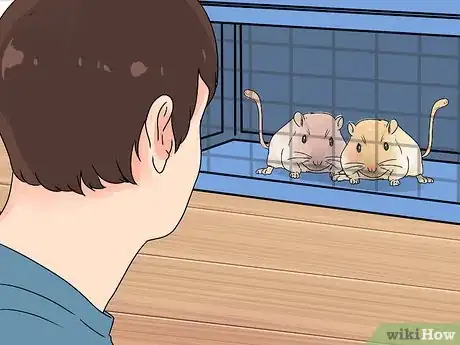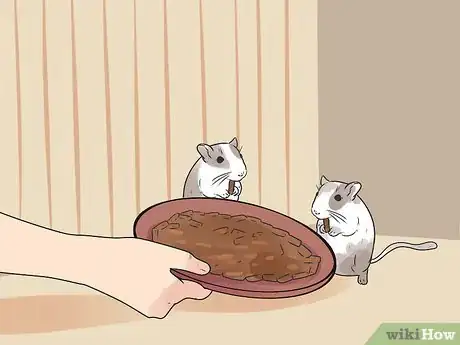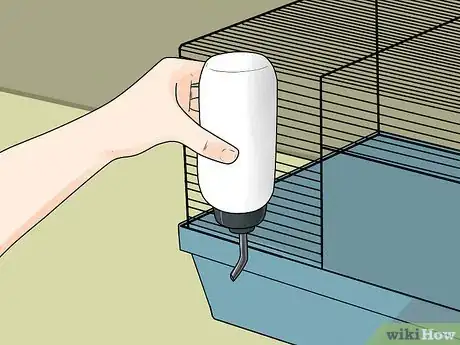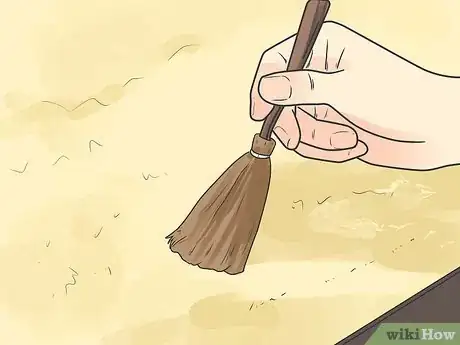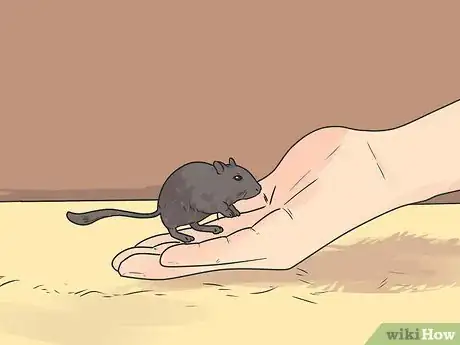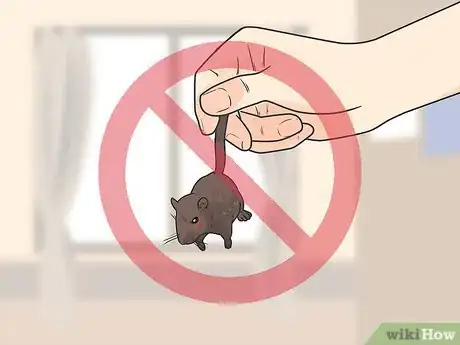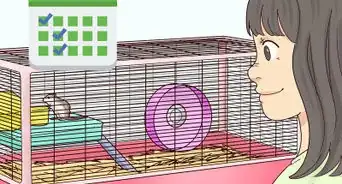This article was co-authored by Pippa Elliott, MRCVS. Dr. Elliott, BVMS, MRCVS is a veterinarian with over 30 years of experience in veterinary surgery and companion animal practice. She graduated from the University of Glasgow in 1987 with a degree in veterinary medicine and surgery. She has worked at the same animal clinic in her hometown for over 20 years.
wikiHow marks an article as reader-approved once it receives enough positive feedback. This article received 18 testimonials and 87% of readers who voted found it helpful, earning it our reader-approved status.
This article has been viewed 466,181 times.
Gerbils are a popular type of pet for good reason; they’re friendly, social, inquisitive, and overall just amazing creatures! They normally like to be in a same-sex pair or group (unless you want to breed) but you will possibly come across one or two that like to be by themselves. Although they are not as expensive as a cat or a dog, they will require daily attention and care. Perhaps most importantly, you need to provide a suitable habitat that will allow them to burrow as they would in the wild.
Steps
Adopting Gerbils
-
1Find a breeder. The best option is to purchase from a breeder. Because of the number of animals at a pet store, these establishments can have difficulty keeping track of the gender of gerbils and their relationship to one another. This is problematic since they are both social and territorial, requiring carefully planned interaction. A gerbil breeder is more likely to know the gender of the gerbil, whether two gerbils are familiar with one another, and whether they are related.[1]
- A breeder should allow you to meet the parents of your gerbils. Ask to do this and verify that you like their disposition and health. Many of their traits will be passed on to their litter.
- Ask the breeder questions about the pup and its litter. Was it born healthy? What percentage of the litter died? How inbred are the parents? How do the parents interact with other gerbils?
-
2Look for healthy and friendly gerbils. Even healthy gerbils are only likely to live for two to four years. You should be attentive, therefore, to signs that your gerbil is ill. There are also some cues which will indicate whether or not the gerbil is likely to be friendly.
- For healthy gerbils, look for a tail that is as long as the body and full of fur, the fur should be shiny, it is a sign of good health much like humans; eyes that are shiny, large, bright and clear; and a body that is thick and stout. Dull or sunken eyes, red noses, bleeding noses, and depressed demeanors suggest that the gerbil is ill.[2] You should not buy a gerbil that has overgrown teeth, patches of fur falling off, diarrhea or has evidence of diarrhea in the cage, seems to be skinny or not eating/drinking, or sneezing and has a running nose.
- The signs that a gerbil is friendly are much what you would expect. It should approach the glass and seek attention. It is natural for young gerbils to nibble a bit with their mouth, as a way to explore their surroundings. This, however, should not be painful. If the gerbil bites you hard, it is likely anti-social. [3]
Advertisement -
3Adopt multiple gerbils. Gerbils are naturally social animals and will get depressed and listless if left to themselves. You should always purchase at least two and perhaps more. Usually, the optimal arrangement for a first-time owner is to purchase two gerbils of the same sex. If your gerbils breed, it can be both an expensive and complicated process for you.
- Recognizing the sex of two gerbils is not always easy. To do so, turn them over on their back in your hand. At three weeks old, females will exhibit a shorter distance between their urinary and anal openings. At five to seven weeks of age, males will develop prominent testicles that will make identification easier. The qualified assistance of a professional will help, but, depending upon the establishment, the owner might not have sufficient knowledge of the gerbil’s background to provide much guidance.[4]
-
4Find gerbils that like one another. This can be difficult if the seller does not have sufficient knowledge of their interactions. If possible you should purchase gerbils that are from the same litter and somewhere from six to eight weeks old. This is the optimal time for them to establish relationships with each other. If this is not possible, you can introduce them with the split cage method.
- To introduce unfamiliar gerbils to one another, purchase an aquarium divider. Place it in the middle of the tank and place the gerbils on different sides of the tank. Switch which side the gerbils are on several times per day so that they become accustomed to the other’s scent.
- After about a week lift the divider and monitor the gerbils closely for a day. While it is okay if they box slightly, if they spring into the air or start rolling around in a ball fighting, these are indications that they are aggressive and should be separated immediately. Conversely, if they sleep together, this means that they have bonded.
- If this procedure fails, try three more times. If it still does not work, it is probable they will never be able to get along.
- Never try to introduce a bonded pair to a third gerbil. They will gang up on the unfamiliar newcomer.[5]
-
5Purchase housing. The best habitat for a gerbil is a large glass tank. For two Gerbils a 10-gallon tank should suffice. For each additional gerbil, the tank should be 5 gallons (18.9 L) larger. Fill up a third of the tank with a substrate like Megazorb, Finacard, Carefresh, or Bedexcel that the gerbils can dig in. Sufficient room to burrow is necessary to keep your gerbils active and entertained.
- Never line the bottom with sawdust because pine and cedar wood shavings can cause serious respiratory problems.
- You will need a top to protect the gerbils. The best option is something like a fine wire mesh that can be purchased at a pet store. These are optimal because you can hang items from them, including a wheel and a water bottle.
- Avoid cages. Gerbils can easily get their feet caught in wire. Be mindful of this when purchasing anything for their home, including wheels.[6]
Caring for Your Gerbil
-
1Feed your gerbil well. The first step to good health is a good diet. Like us, gerbils need a balanced diet of greens, protein, fats, and vitamins. Their base diet should be a commercially produced gerbil food, because these are designed to accommodate all of their nutritional needs. However, this can be augmented with occasional treats. Food should be scattered across the surface of the bedding.
- Start with gerbil pellets or combinations of seeds marketed at the pet store for gerbil consumption.
- Gerbils like seeds, but avoid giving them too many sunflower seeds, as these are particularly fatty. Pumpkin seeds are better. Occasionally give them cheese for extra protein but don't give it to them regularly as it can result in them being obese and unwell.
- Supplement their dried food with fresh, healthy fruits and vegetables, including pear, melon, apple, oranges, cucumbers, carrots, pumpkins, and fennel. Rhubarb and grapes, on the other hand, are poisonous to gerbils.[7] Hay is also a popular and healthy treat for gerbils; use the type available at pet stores.[8]
- You do not need bowls. Scattering food is easier for you and better for your gerbils as it encourages their natural instinct to forage, while discouraging fighting.
-
2Equip the bowl with a water bottle. Get one with a nice metal spout. It helps if the body is composed of clear plastic, so you can see how full it is with a glance. Hang it from a mesh lid on a glass aquarium or through the bars of your topper. Clean the spout regularly. Refill frequently enough that the gerbils always have access to water.
-
3Make a bed. A simple wooden box is ideal for nesting. These can be purchased at a store. Shred tissue paper into small strips and place into the box to make your gerbils bed complete.
-
4Clean cage periodically. You should check the cage daily and remove any stale food that has not been eaten. Otherwise gerbils are relatively clean. The bedding will need to be replaced, but not more than once a week.
Enriching Your Gerbil’s Life
-
1Encourage play and exercise. Exercise is also important to any pet's health. Luckily gerbils are naturally active. Space and bedding for digging are the most important requirements for gerbils. Other items, however, can help.
- A solid wheel can provide great exercise. If it is not solid, the gerbil can get its feet or tail stuck and hurt itself. A good wheel is one that has no gaps in it but has ridges to use and run on. Also be sure to suspend the wheel off the ground from the wire top, so that it does not take up space in the cage.
- Pet stores sell wooden chew toys for gerbils that can provide entertainment.
- An exercise ball is the best way to allow your gerbil to explore the wider world and get a workout. Just beware that your gerbil may not like the confined space so if they show signs of being stressed, take them out immediately and do not put them back in there until they are calm the next day.[9]
- Gerbils also love cardboard. A cheap way to entertain gerbils is to give them the cardboard center of a roll of toilet paper after you have used it up.
-
2Take it slow. When you first adopt your gerbil, it might be too disturbed by its new environment to be friendly. Do not try to pick it up for the first couple of days. You can, however, begin to build positive associations with it by hand-feeding it seeds, a good sign of it trusting you is when it climbs onto your hand and stays there as it eats. If it runs away with the food to a small space or a corner, do not worry because this is natural as in the wild a gerbil will have to fight for its food.[10]
-
3Handle with care. You will want to handle the gerbil often so that it becomes accustomed to human interaction. A happy gerbil will receive daily social interaction. However, you should be careful. Wash your hands before handling. Use both hands to create a big bowl that will support the gerbil. Place your hands next to the gerbil so that it will walk up on to them.
- Avoid standing directly above the gerbil. It will associate any shadows being cast on it with predators, causing agitation.
-
4Do not pick up your gerbil by the tail; this can break the tail. If you absolutely have to pick it up by the tail for whatever reason, do so by gently but firmly holding the bit nearest the gerbil's body, this reduces the risk of it releasing its tail and running away. You should try to cup the gerbil and hold it carefully. You can also take them into your bathroom and play with them in the bathtub because it is a great way to get to know their personality and characteristics and also for them to get to know your scent and movements.[11]
-
5Do not attempt to breed unless experienced with gerbil care. A pair of gerbils can produce ninety-six pups a year. Those pups will soon begin to produce more babies. Unless you have considerable experience with gerbils, you should verify that you have no mixed-sex pairs in your possession. Otherwise you will shortly be responsible for a small army of gerbils.
- However, if you do choose to breed, don't take the male away and re-introduce him later on, the female will hurt him as she will be protecting her pups from a 'stranger'. Males can take a great role as father but almost immediately after the pups are born, the adults will mate again and over time may make the female unwell.
Expert Q&A
-
QuestionWhat is the best temperature for gerbils?
 Pippa Elliott, MRCVSDr. Elliott, BVMS, MRCVS is a veterinarian with over 30 years of experience in veterinary surgery and companion animal practice. She graduated from the University of Glasgow in 1987 with a degree in veterinary medicine and surgery. She has worked at the same animal clinic in her hometown for over 20 years.
Pippa Elliott, MRCVSDr. Elliott, BVMS, MRCVS is a veterinarian with over 30 years of experience in veterinary surgery and companion animal practice. She graduated from the University of Glasgow in 1987 with a degree in veterinary medicine and surgery. She has worked at the same animal clinic in her hometown for over 20 years.
Veterinarian The ideal temperature range for gerbils is from between 20℃ and 24℃ (68 to 75°F).
The ideal temperature range for gerbils is from between 20℃ and 24℃ (68 to 75°F). -
QuestionOne of my gerbils has died, what shall I do with the other one?
 Pippa Elliott, MRCVSDr. Elliott, BVMS, MRCVS is a veterinarian with over 30 years of experience in veterinary surgery and companion animal practice. She graduated from the University of Glasgow in 1987 with a degree in veterinary medicine and surgery. She has worked at the same animal clinic in her hometown for over 20 years.
Pippa Elliott, MRCVSDr. Elliott, BVMS, MRCVS is a veterinarian with over 30 years of experience in veterinary surgery and companion animal practice. She graduated from the University of Glasgow in 1987 with a degree in veterinary medicine and surgery. She has worked at the same animal clinic in her hometown for over 20 years.
Veterinarian Gerbils have a reputation for being group animals and loving company, but a lone gerbil will be just fine if you give him extra attention. Be sure to talk and play with him at least a couple of times a day, and make sure his cage is interesting by providing cardboard tubes for him to explore and investigate.
Gerbils have a reputation for being group animals and loving company, but a lone gerbil will be just fine if you give him extra attention. Be sure to talk and play with him at least a couple of times a day, and make sure his cage is interesting by providing cardboard tubes for him to explore and investigate.
Warnings
- Gerbils box and wrestle for fun, but sometimes fights turn nasty. If blood is drawn, you'll need to separate them immediately. Use gloves to protect your hand. Do not separate for a day or longer unless you intend to permanently separate them. After a day they will lose their scent memory of each other and will no longer be bonded as mentioned with the parents from earlier.⧼thumbs_response⧽
- Modular systems such as rotastak and habit-rail are not suitable for gerbils[12] , and neither are hamster cages. They must have room to burrow.⧼thumbs_response⧽
- Males can get tumors on their scent gland (a yellowy line down their stomach) as they use it more than females to mark their territory and make it homely.⧼thumbs_response⧽
Things You'll Need
- good gerbil food
- An upright water bottle
- large aquarium
- aspen or Care fresh bedding(not cedar or pine)
- straw, hay, paper(no ink), cardboard, or tissue to use for the nest
- wheel
- salt/mineral lick
- sundried sweet corn
- small hut
- plastic tunnels (for simulation of natural burrows)
- a piece of untreated clean and healthy wood from a pet shop for chewing
- gerbil toys (hamster toys can also be used)
References
- ↑ http://gerbils.silvanon.com/purchasing_a_gerbil.html
- ↑ http://gerbils.silvanon.com/purchasing_a_gerbil.html
- ↑ http://gerbils.silvanon.com/purchasing_a_gerbil.html
- ↑ http://gerbils.silvanon.com/purchasing_a_gerbil.html
- ↑ http://gerbils.silvanon.com/purchasing_a_gerbil.html
- ↑ https://www.aaha.org/pet_owner/pet_health_library/other/general_health/caring_for_your_gerbil.aspx
- ↑ http://www.rspca.org.uk/adviceandwelfare/pets/rodents/gerbils/diet
- ↑ http://www.thegerbils.com/maintenance3food.htm
- ↑ https://www.aaha.org/pet_owner/pet_health_library/other/general_health/caring_for_your_gerbil.aspx
About This Article
To care for gerbils, keep them in a large glass tank filled a third of the way with a substrate the gerbils can dig in. Feed your gerbils a commercially produced gerbil food that you sprinkle across the substrate daily, and supplement their diet with fresh fruits and vegetables like pears, apples, carrots, and pumpkins. Remove uneaten food daily and change the bedding once a week. Since gerbils are social, adopt at least 2 healthy gerbils of the same sex, preferably from the same litter, to keep them from getting lonely. For tips from our veterinary reviewer on playing with your gerbils, read on!



